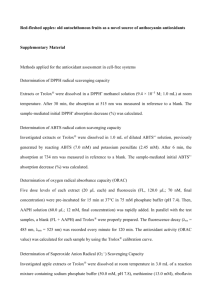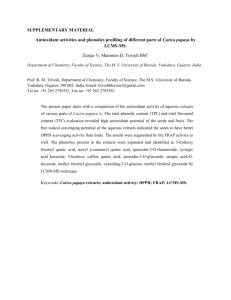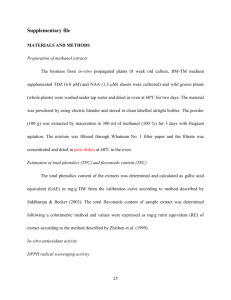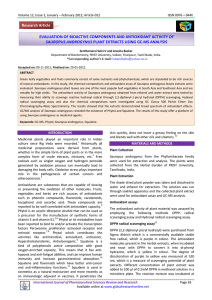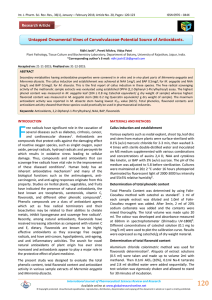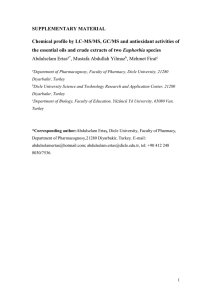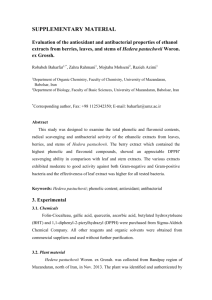Current Research Journal of Biological Sciences 4(5): 600-607, 2012 ISSN:
advertisement
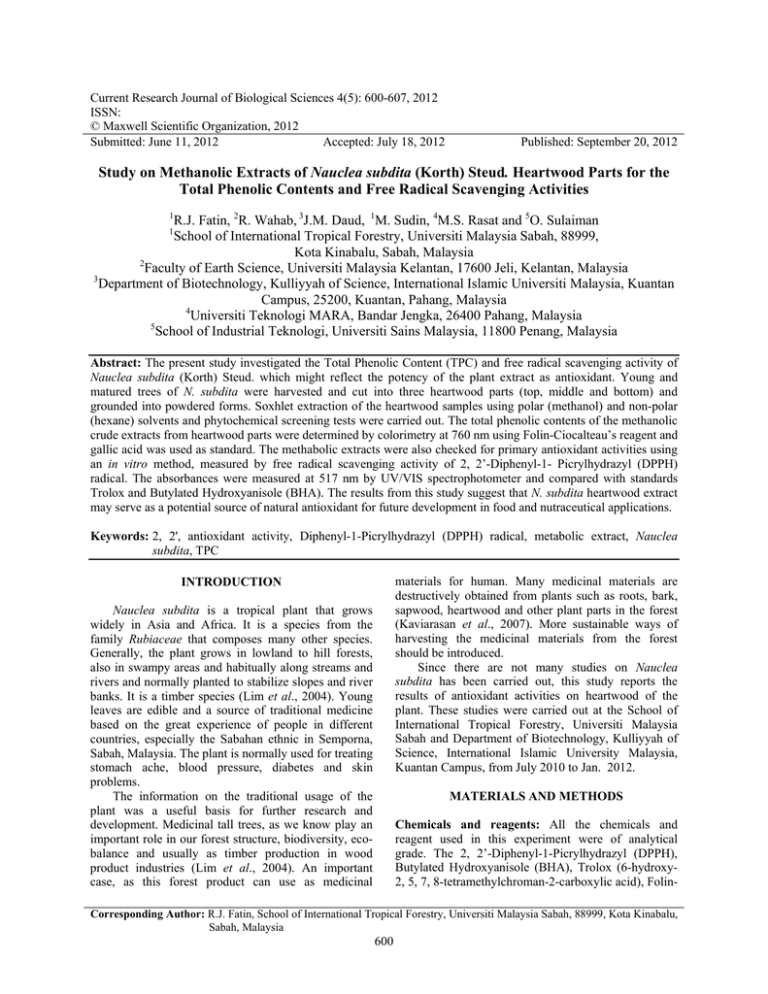
Current Research Journal of Biological Sciences 4(5): 600-607, 2012 ISSN: © Maxwell Scientific Organization, 2012 Submitted: June 11, 2012 Accepted: July 18, 2012 Published: September 20, 2012 Study on Methanolic Extracts of Nauclea subdita (Korth) Steud. Heartwood Parts for the Total Phenolic Contents and Free Radical Scavenging Activities 1 R.J. Fatin, 2R. Wahab, 3J.M. Daud, 1M. Sudin, 4M.S. Rasat and 5O. Sulaiman School of International Tropical Forestry, Universiti Malaysia Sabah, 88999, Kota Kinabalu, Sabah, Malaysia 2 Faculty of Earth Science, Universiti Malaysia Kelantan, 17600 Jeli, Kelantan, Malaysia 3 Department of Biotechnology, Kulliyyah of Science, International Islamic Universiti Malaysia, Kuantan Campus, 25200, Kuantan, Pahang, Malaysia 4 Universiti Teknologi MARA, Bandar Jengka, 26400 Pahang, Malaysia 5 School of Industrial Teknologi, Universiti Sains Malaysia, 11800 Penang, Malaysia 1 Abstract: The present study investigated the Total Phenolic Content (TPC) and free radical scavenging activity of Nauclea subdita (Korth) Steud. which might reflect the potency of the plant extract as antioxidant. Young and matured trees of N. subdita were harvested and cut into three heartwood parts (top, middle and bottom) and grounded into powdered forms. Soxhlet extraction of the heartwood samples using polar (methanol) and non-polar (hexane) solvents and phytochemical screening tests were carried out. The total phenolic contents of the methanolic crude extracts from heartwood parts were determined by colorimetry at 760 nm using Folin-Ciocalteau’s reagent and gallic acid was used as standard. The methabolic extracts were also checked for primary antioxidant activities using an in vitro method, measured by free radical scavenging activity of 2, 2’-Diphenyl-1- Picrylhydrazyl (DPPH) radical. The absorbances were measured at 517 nm by UV/VIS spectrophotometer and compared with standards Trolox and Butylated Hydroxyanisole (BHA). The results from this study suggest that N. subdita heartwood extract may serve as a potential source of natural antioxidant for future development in food and nutraceutical applications. Keywords: 2, 2', antioxidant activity, Diphenyl-1-Picrylhydrazyl (DPPH) radical, metabolic extract, Nauclea subdita, TPC materials for human. Many medicinal materials are destructively obtained from plants such as roots, bark, sapwood, heartwood and other plant parts in the forest (Kaviarasan et al., 2007). More sustainable ways of harvesting the medicinal materials from the forest should be introduced. Since there are not many studies on Nauclea subdita has been carried out, this study reports the results of antioxidant activities on heartwood of the plant. These studies were carried out at the School of International Tropical Forestry, Universiti Malaysia Sabah and Department of Biotechnology, Kulliyyah of Science, International Islamic University Malaysia, Kuantan Campus, from July 2010 to Jan. 2012. INTRODUCTION Nauclea subdita is a tropical plant that grows widely in Asia and Africa. It is a species from the family Rubiaceae that composes many other species. Generally, the plant grows in lowland to hill forests, also in swampy areas and habitually along streams and rivers and normally planted to stabilize slopes and river banks. It is a timber species (Lim et al., 2004). Young leaves are edible and a source of traditional medicine based on the great experience of people in different countries, especially the Sabahan ethnic in Semporna, Sabah, Malaysia. The plant is normally used for treating stomach ache, blood pressure, diabetes and skin problems. The information on the traditional usage of the plant was a useful basis for further research and development. Medicinal tall trees, as we know play an important role in our forest structure, biodiversity, ecobalance and usually as timber production in wood product industries (Lim et al., 2004). An important case, as this forest product can use as medicinal MATERIALS AND METHODS Chemicals and reagents: All the chemicals and reagent used in this experiment were of analytical grade. The 2, 2’-Diphenyl-1-Picrylhydrazyl (DPPH), Butylated Hydroxyanisole (BHA), Trolox (6-hydroxy2, 5, 7, 8-tetramethylchroman-2-carboxylic acid), Folin- Corresponding Author: R.J. Fatin, School of International Tropical Forestry, Universiti Malaysia Sabah, 88999, Kota Kinabalu, Sabah, Malaysia 600 Curr. Res. J. Biol. Sci., 4(5): 600-607, 2012 Ciocalteu and other chemicals and solvents such as methanol and hexane. All the chemicals were obtained from Sigma or Merck. Sample preparation: Collection and identification of N. subdita plant materials with different types, young and a mature tree were collected fresh from forest sources in Pitas, Sabah in March 2010 and have been identified by experts at the Forest Research Institute Malaysia (FRIM), Kepong. The young and matured trees of N. subdita were cut into 3 portions (top, middle and bottom). The tree portions of wood were chopped into small part, grinded into particles and dried in the room temperature with air-conditioner for 2 weeks and the samples was dried in freeze dryer before extraction. The dry powdered of wood materials were blended using a laboratory blender after took weight of the powdered samples. Extraction analysis and physiochemical screening method: Ground samples in the form of dried fine powder (100 g each placed in cellulose timble) were extracted in soxhlet extractors using non-polar solvent (hexane) and polar solvent (methanol) separately for 72 h, following the method (Sengul et al., 2009). The extracts were concentrated under vacuum at 60ºC using a rotary evaporator. The solid residues obtained after the rotary evaporation process were dried, kept in glass vials and stored in a refrigerator. The residues were taken from the refrigerator the subsequent experiments. The yields for methanol extract from each sample were the top, middle and bottom from portions from both maturity groups of trees in heartwood parts. Physiochemical screening was performed in accordance to the standard procedures. A qualitative photochemical test was performed to detect the presence of phenolic compounds (ferric chloride and gelatin tests), flavanoids, tannins, phytostrols (Libermann-Burchard’s test), terpenoids (Salkowski test), steroids, alkaloids, cardiac glycoside (KellerKilliani test) and saponins are carried out using standard procedures as described by Abubakar et al. (2008) and Kumar et al. (2007). Total phenolic content: The total phenolic content of the extracts were determined by the Folin-Ciocalteau method with some modifications (Azlim Almey et al., 2010; Rankovic et al., 2011). Gallic acid was used as standard. 0.5 mg/mL stock standard solution of Gallic acid was prepared by dissolving 250 mg of dry Gallic acid in 1 mL of 70% of methanol and then diluted into 500 mL of distilled water; the stock solution was stored at 4°C. Working standards of between 0.02 to 0.10 mg/mL were prepared by diluting the stock solution with distilled water. The extracts were prepared, 100 µL of each extract was transferred into a test tube and 0.75 mL of Folin-Ciocalteu reagent was added and mixed (previously diluted 10 times with distilled water). The above solution was then kept for incubation at room temperature for 5 min, then 0.75 mL of 6% (w/v) sodium carbonate was added to the mixture and mixed gently, vortex thoroughly. After standing at room temperature for 90 min, the absorbance was measured at 760 nm using a perkin-elmer UV-VIS lambda 25 spectrophotometer (Rankovic et al., 2011). Gallic acid was used to produce standard calibration curve was plotted in the range of 0.02 to 0.10 mg/mL. The total phenolic content was expressed in g of Gallic Acid Equivalents (GAE) /100 g of extract. Free radical scavenging activity by DPPH method: The antioxidant activity between the samples of the sapwood, heartwood and bark extracts of N. subdita was determined using the 2,2’-Diphenyl-1Picrylhydrazyl (DPPH) free radical scavenging assay by the referred method (Ludmila et al., 2003; Guno and Prashant, 2010). The radical scavenging activity was determined by a modified method described by Ayoola et al. (2008). The crude extracts of heartwood from N. subdita were mixed with 95% methanol to prepare the stock solution (300 mg/3000 mL). The test samples will prepare from stock solution. The extracts were prepared at concentrations of 0.2, 0.3, 0.6, 1.3, 2.5 and 5.0 mg/mL in methanol (Analar grade). DPPH solution will prepare in methanol. Freshly prepare DPPH solution were added in each of this test tube containing N. subdita extracts and allowed to stand for 30 min in the dark. The absorbance were taken at 517 nm using a spectrophotometer. BHA and Trolox acid were use as standard (Nurliyana et al., 2010; Paduch et al., 2008). The DPPH solution without sample solution was use as negative control. Nintyfive percent methanol was use as blank. Percent scavenging of the DPPH free radical will measure using the following equation: Scavenging capacity (%) = Absorbance of test sample 1 - -------------------------------- x 100 Absorbance of the control An IC50, the amount of samples extracted into 1 mL solution necessary to decrease by 50% the initial DPPH concentration was derived from the % disappearance vs. concentration plot (Concentration here means mg of crude extracted into 1 mL solution) (Manjunatha et al., 2011). IC50 values were calculated in mg dried material equivalents/mL for sample extracts. BHA and Trolox were used as positive control. 601 Curr. Res. J. Biol. Sci., 4(5): 600-607, 2012 Table 1: Phytochemical screening of young tree Phenolic Plant 1 compound Flavanoids Tannins Steroids Hexane P1TW + P1MW + + P1BW + Methanol P1TW + + + P1MW + + + P1BW + + + +: Present; -: Absent; W: Wood; P1: Young tree; T: Top; M: Middle; B: Bottom Table 2: Phytochemical screening of mature tree Phenolic Plant 2 compound Flavanoids Tannins Phytosterols Phytosterols Terpenoids Alkaloids Saponin Cardiac glycoside - - - - + + + + + + + + + - Steroids Terpenoids Hexane P1TW + P1MW + + P1BW + Methanol P1TW + + + + P1MW + + + + P1BW + + + + +: Present; -: Absent; W: Wood; P2: Mature tree; T: Top; M: Middle; B: Bottom All the antioxidant measurements were performed in triplicate and the data were expressed as average±Standard Deviations (SD). Statistical analysis: All the antioxidant measurements were performed in triplicate and the data were expressed as average±Standard Deviations (SD). Twoway Analysis of Variance (ANOVA), Duncan's tests was carried out to test any significant differences between treatments. A p<0.05 was considered as statistically significant. RESULTS AND DISCUSSION Phytochemical screening and extraction analysis: The presence of natural product compounds as indicated during phytochemical screening are summarized in Table 1 and 2. Screening tests of the methanolic crude extracts of N. subdita revealed the presence of phenolic compound, flavanoids, terpenoids, alkaloids, phytosterols and saponins in the heartwood of young and mature plants, whereas only phytosterols were detected in hexane extracts. Based on the results of the screening tests, only the crude extracts of N. subdita were further studied for antioxidant properties. The yields for methanol extract from each sample young were; P1T (0.740 g), P1M (0.638 g) and P1B (0.761 g) (Table 3). A second extraction cycle was done to obtain more samples for the tests. Second extraction yielded for P1T (0.910 g), P1M (0.434 g) and P1B (0.820 g) ( Table 3). The yields for methanol extract from each sample mature were; P2T (0.138 g), P2M (0.144 g) and P2B (0.265 g) (Table 4). A second extraction cycle was done to obtain more samples for Alkaloids Saponin Cardiac glycoside - - - + + + + + + - Table 3: Extraction yields for the young tree Extracted parts First extraction (g) Second extraction (g) P1T 0.740 0.910 P1M 0.638 0.434 P1B 0.761 0.820 P1: Young tree; W: Wood; T: Top; M: Middle; B: Bottom Table 4: Extraction yields for the mature tree Extracted parts First extraction (g) Second extraction (g) P2T 0.138 0.238 P2M 0.144 0.232 P2B 0.265 0.289 P2: Mature tree; W: Wood; T: Top; M: Middle; B: Bottom the tests. Second extraction yielded for P2T (0.238 g), P2M (0.232 g) and P2B (0.289 g) (Table 4). Hexane extraction has yielded negligible weight of residue, which indicated the low non-polar content of the sample and the relatively high presence of polar compounds. The study continued with methanol extracts only and hexane extracts were eliminated. Total Phenolic Content (TPC) assay: The TPCs (in g Gallic Acid Equivalent (GAE)/100 g extract) of young and mature tree samples of N. subdita were investigated as shown in Fig. 1. The middle and bottom parts of heartwood samples for young tree had almost two times higher TPCs when compared to samples of the mature trees. Whereas TPCs of the top part of both young and mature heartwoods were almost equal, but still lower than top and bottom parts of the young heartwoods. The bottom part of young heartwood has the highest TPC (5.359±0.000 g GAE) and the lowest TPC (3.206±0.005 g GAE) for the bottom part of mature heartwood. All phenolic compounds of plant origin have the structural requirements as free radical scavengers and have potential as antioxidants (Jayathilakan et al., 602 Cuurr. Res. J. Bioll. Sci., 4(5): 6000-607, 2012 Fig. 1: Com mparison between n maturity groupps in heartwood parts of TPC; Level L of TPCs inn heartwoods of young and matuure tree of N. N subdita in g GAE/100 G g extracct Fig. 2: Com mparison of hearttwood parts betw ween portions annd maturity grouups in radical scaavenging activityy; Mean±S.D. annd IC50 of BHA B and trolox 2007). In this t study, galllic acid was used u as referennce standard foor TPC and thee antioxidant leevel is expresssed in g Gallicc Acid Equivaalent (GAE) per p 100 g of the t plant extraacts (Lim et al., 2007; Norshazila N et al., a 2010), sincce gallic acid iss one of the maajor polyphenoolic compounds in plants. m and standaard deviation result r of phenoolic The mean content of all part of sam mples extracts which w is by usiing methanol is summarizeed in Fig. 1. The oxidatioonr of an ntioxidant com mpounds with the t reduction reaction Folin-Cioccalteau reagen nt is the bassis of the TP PC measuremeent (Verzellon ni et al., 20007). A purpplecoloured solution was produced when w N. subddita a extracts reeacted with Folin-Ciocalteeau reagent and sodium carrbonate. The in ntensity of the purple colour of phosphomoolybdic-phosph hotungstic-pheenolic compllex increases as the TPC Cs of the exxtract increassed 0). The resultts indicated thhat (Nurliyanaa et al., 2010 young heartwood off N. subdita trrees contains higher h TPC thhan the mature heartwood. Exxcess free raddicals such ass superoxide anion radicalss and peroxy radicals r in the human body can c be scavengged by gallic acid a or any equuivalents comppounds and prrotect human tissues againnst oxidative stress (Rankaadilok et al., 2006). The plants with high potential of phenolicc compounds to t scavenge raadicals such as a singlet oxxygen, superoxxide and hyddroxyl radicalss may be expllained by theiir phenolic hyddroxyl groups (Rankovic et al., a 2011). Free radical scavvenging activvity: The prrimary antioxidant activitiess of N. subditaa parts in meethanol extractss were meaasured using 2, 2’-Dipheenyl-1Picrylhhydrazyl (DPPH H). The DPPH H radical scaveenging activities were determ mined through 517 nm absorrbance T measurrement. Scavennging activity of BHA and Trolox was useed as the standdard. The meann of measurem ment of 603 Cuurr. Res. J. Bioll. Sci., 4(5): 6000-607, 2012 Fig. 3: The radical r scavengiing activity betw ween portions in young trees show wing mean±S.D D. and IC50 Fig. 4: The radical r scavengiing activity betw ween portions in mature trees shoowing mean±S.D D. and IC50 absorbancee was calculaated using forrmulation statted earlier (Scavenging ( capacity formulae). fo T The percentagees of inhibition n of free radiccal by both BH HA and Troloxx as standards are depicted inn Fig. 2, whereeas for young and mature treees are shownn in Fig. 3 andd 4. According to Fig. 3 and d 4 showed thhe DPPH radiccal scavengingg activity of maturity m groupss between youung and maturee trees from diifferent portionns were Top (T T), Middle (M M) and Bottom (B). The Fig. 3 and 4 show wed the mean and S.D. in P1T, P1M annd P1B wheree 6 concentratiion are tested in these studdies. All samples showed the trend increase when inhibbit from lower to the higher concentration. The IC50 of Trolox T and BH HA are 0.11 and a 0.09 mg/m mL respectively (Fig. 2). The T antioxidant standards ussed in this stuudy (Trolox and a BHA) exhhibited good frree radical scaavenging activvity from 96% of scavenging g activity. Thee Fig. 3 show wed IC50 of PIT (>5 mg/mL L), PIM (3.5 mg/mL) m and P1B (1.71 mg/m mL) in young g trees of heaartwood extraccts, which indiicates the rem markable antioxxidant activity of the extractts. The Fig. 4 showed the P2T P (>5 mg/mL L), >5 mg/mL) annd P2B (4.91 mg/mL) of mature m P2M (> trees inn heartwood extracts. e From m the graph, it i was shown that the streength of the scavenging activity followeed the order off BHA > Troloxx > methanol. In the presentt of study, methanolic exxtracts of saamples showedd the potential free-radical scavenging activvity. Thhe TPC of N. suubdita heartwoood parts were found higher in young treees compared to t the mature tree's extractss. As we can seee every portioon show the vaarieties of the result where some parts arre higher and lower C50 level. The free-radical sccavenging activvity of from IC the exttracts was evvaluated basedd on the abillity to scavengge the synthettic DPPH. DPP PH has been widely w employyed to evaluuate the free--radical scaveenging activityy of natural anttioxidants. Thiss plant can be higher h than standard s from m the isolationn pure comppound. Researcch also indiicates that thhe DPPH teest is particularly suitable for the evaluaation of antiooxidant 2 activityy of crude exxtracts (Nurliyyana et al., 2010). DPPH is the param magnetic comppound with ann odd 604 Curr. Res. J. Biol. Sci., 4(5): 600-607, 2012 Table 5: Percent inhibition of young trees measured by DPPH, three replicate, significant value p<0.05, Duncan’s multiple test, two-way ANOVA Young tree -------------------------------------------------------------------------------------------------Tree portions Concentration (mg/L) Means±S.D. IC50 Top 0.156 4.767±0.281 0.313 5.780±0.303 0.625 7.780±0.225 >5.0 mg/mL 1.250 15.277±0.247 2.500 22.097±0.671 5.000 31.767±0.281 Middle 0.156 24.237±0.091 0.313 31.037±0.048 0.625 35.827±1.096 3.5 mg/mL 1.250 42.300±1.048 2.500 45.110±0.684 5.000 69.557±0.489 Bottom 0.156 24.267±0.983 0.313 27.710±0.693 0.625 42.027±0.074 1.71 mg/mL 1.250 42.180±0.000 2.500 56.050±0.130 5.000 70.517±0.368 Young tree F = 842.898* Concentration F = 105.476* Interaction F = 49.649* IC50: Inhibition concentration electron shows strong absorption band in methanol. DPPH shows a strong absorption band at 760 nm in the visible spectrum (deep purple color) (Norshazila et al., 2010). As the electron became paired off in the presence of free radical scavenging, the absorption vanishes and the resulting discoloration stoichiometrically coincides with respects to the number of electrons taken up (Rankovic et al., 2011). The scavenging activity of antioxidants by hydrogen donation decreases the absorbance as the color changes from purple to yellow. It is strongly recommended that a fresh DPPH is prepared prior to assay (Rankovic et al., 2011). The N. subdita heartwood parts extract showed promising free radical scavenging effect of DPPH in a concentration dependent manner. The reference standard BHA and Trolox also demonstrated a significant radical scavenging potential in the concentration used (Norshazila et al., 2010). The extracts of N. subdita were considered to play important roles in the prevention the diseases and may lower the risk of the diseases. The Table 5 and Table 6 showed all results of heartwood extracts between three portions in mean and S.D. in 6 concentration used. These graphs showed that inhibition percentage of BHA and Trolox with 6 different concentrations. The result presented that P1T showed a maximum inhibition with 31.767±0.281 of maximum inhibition and 4.767±0.281 of minimum inhibition as minimum at 0.3125 concentrations. The result presented that P1M showed a maximum inhibition of 69.557±0.489 at maximum concentration used and 24.237±0.091 at the least concentration. The result presented that for sample P1B had 70.517±0.368 maximum inhibition and 24.267±0.983 of minimum. The result presented for sample P2T had 30.250±0.632 maximum inhibitions and 4.0167±0.013 of minimum. The result presented for sample P2M had 37.427±1.173 maximum inhibitions and 15.990±0.476 of minimum. The result presented for sample P2B had 48.970±0.598 maximum inhibitions and 9.537±0.394 of minimum. All analyses were the mean of triplicate measurements±S.D. and results are expressed in percent of free radical inhibition. All samples are significant between portions but not significant between maturity groups. Table 5 and 6 shows the ANOVA on percent inhibition of the young and mature trees measured by DPPH with values of mean±S.D., IC50 and F values. There were significant differences between young or mature tree and between concentrations of the samples. The interaction between trees and concentration of young and mature trees are F is equal to 49.649 and 97.323, respectively. Usually, antioxidant activities are expected in presence of phenolic hydroxyl or methoxyl groups, flavone hydroxyl, keto groups, free carboxylic groups and other structural features (Bhuiyan et al., 2010). DPPH assay is to measure the primary antioxidant activity of each sample in the present study. The antioxidant shows the ability to remove the color 605 Curr. Res. J. Biol. Sci., 4(5): 600-607, 2012 Table 6: Percent inhibition of mature tree measured by DPPH, three replicate, significant value p<0.05, Duncan’s multiple test, two-way ANOVA Mature tree ------------------------------------------------------------------------------------------------Tree portions Concentration (mg/L) Means±S.D. IC50 Top 0.156 4.0167±0.013 0.313 5.7767±0.394 0.625 6.927±0.134 >5.0 mg/mL 1.250 13.677±0.152 2.500 20.677±0.394 5.000 Middle 0.156 15.990±0.476 0.313 20.517±0.992 0.625 22.220±0.684 >5.0 mg/mL 1.250 24.890±0.182 2.500 27.857±0.585 5.000 37.427±1.173 Bottom 0.156 9.537±0.394 0.313 10.937±0.524 0.625 12.667±0.082 4.91 mg/mL 1.250 22.397±0.983 2.500 30.887±0.212 5.000 48.970±0.598 Mature tree F = 771.464* Concentration F = 1.219* Interaction F = 97.323* IC50: Inhibition concentration changes from purple to yellow due to the ability of hydrogen donating. The degree of discoloration indicates the scavenging potential of the antioxidant compounds or extracts in terms of hydrogen donating ability. The absorbance show decreases shortly that will show the highest potent of primary anti-oxidant activity (Nurliyana et al., 2010). CONCLUSION The methanolic crude extracts of N. subdita show the presence of phenolic, flavanoids, terpenoids, alkaloids, phytosterols and saponins compounds in the heartwood of young and mature N. subdita. The phytosterols were detected in hexane extracts. The hexane extraction yielded negligible weight of residue indicated the low non-polar content of the sample and the relatively high presence of polar compounds. The middle and bottom parts of heartwood samples for the young N. subdita possess twice higher TPCs when compared to samples of the mature trees. Equal amounts of TPCs were obtained from the top part of both young and mature heartwoods, but lower than that of the top and bottom parts of the young heartwoods. Purple-colored solution was produced when N. subdita extracts reacted with Folin-Ciocalteau reagent and sodium carbonate. The intensity of the purple color ofphosphomolybdic-phosphotungstic-phenolic complex increases as the TPCs of the extract increased, which indicate that young heartwood of N. subdita trees contains higher TPC than the mature heartwood. The scavenging activity of the samples showed the trend increase when inhibit from lower to the higher concentration. The antioxidant standards used in this study (Trolox and BHA) exhibited good free radical scavenging activity from 96% of scavenging activity. The methanolic extracts of samples showed the potential free-radical scavenging activity. The TPC of N. subdita heartwood parts was found higher in young compared to the mature trees. The freeradical scavenging activity of the extracts was evaluated based on the ability to scavenge the synthetic DPPH. This plant can be higher than standard from the isolation pure compound. DPPH shows a strong absorption band at 760 nm in the visible spectrum (deep purple color). The scavenging activity of antioxidants by hydrogen donation decreases the absorbance as the color changes from purple to yellow. It is strongly recommended that a fresh DPPH is prepared prior to assay. The N. subdita heartwood parts extract showed promising free radical scavenging effect of DPPH in a concentration dependent manner. The extracts of N. subdita were considered to play important roles in the prevention the diseases and may lower the risk of the diseases. The antioxidant activity observed with the presence of phenolic hydroxyl or methoxyl groups, flavone hydroxyl, keto groups, free carboxylic groups and other structural features. The absorbance decreases show the highest potent of the primary anti-oxidant activity. 606 Curr. Res. J. Biol. Sci., 4(5): 600-607, 2012 ACKNOWLEDGMENT The authors are thankful to the staffs at the School of International Tropical Forestry, UMS and at the Biotechnology Department, UIAM, for their support and encouragement in making this work complete. REFERENCES Abubakar, M.C., A.N. Ukwuani and R.A. Shehu, 2008. Phytochemical screening and Antibacteria activity of Tamarindus indica pulp extract. Asian J. Biochem., 3(2): 134-138. Ayoola, G.A., A.D. Folawewo, S.A. Adesegun, O.O. Abioro, A.A. Adepoju-Bello and H.A.B. Coker, 2008. Phytochemical and antioxidant screening of some plants of apocynaceae from South West Nigeria. Afr. J. Plant Sci., 2(10): 124-128. Azlim Almey, A.A., J.K. Ahmed, S. Zahir, S. Mustapha, M.R. Aisyah and R. Kamarul, 2010. Total phenolic content and primary antioxidant activity of methanolicv and ethanolic extracts of aromatic plants’ leaves. Int. Food Res. J., 17: 1077-1084. Bhuiyan, M.A.R. and M.Z. Hoque, 2010. Free radical scavenging activities of Zizyphus mauritiana. Electronic J. Environ. Agric. Food Chem., 9(1): 199-206. Guno, S.C. and M.G. Prashant, 2010. Free radical scavenging activity of Abutilon indicum (Linn) sweet stem extracts. Int. J. Chemtech Res., 2(1): 526-531. Jayathilakan, K., G.K. Sharma, K. Radhakrishna and A.S. Bawa, 2007. Antioxidant potential of synthetic and natural antioxidants and its effect on warmed-over-flavour in different species of meat. Food Chem., 105(3): 908-916. Kaviarasan, S., G.H. Naik, R. Gangabhagirathi, C.V. Anuradh and K.I. Priyadarsini, 2007. In vitro studies on antiradical and antioxidant activities of fenugreek (Trigonella foenum graecum) seeds. Food Chem., 103: 31-37. Kumar, A.R., K.M. Subburathinam and G. Prabakar, 2007. Phytohemical screening of selected medicinal plants of asclepiadiaceae family. Asian J. Microbiol. Biotechnol. Environ. Sci., 9(1): 177-180. Lim, S.C., K.S. Gan and K.T. Choo, 2004. Identification and Utilization of Lesser-Known Commercial Timbers in Peninsular Malaysia 1: Ara, Bangkal, Bebusok and Bekoi. Publications Branch, FRIM, 29: 139-258. Lim, Y.Y., T.T. Lim and J.J. Tee, 2007. Antioxidant properties of several tropical fruits: A comparative study. Food Chem., 103: 1003-1008. Ludmila, H., M. Buckova, P. Tarapcik, S. Silhar and J. Labuda, 2003. Comparison of antioxidative activity data for aqueous extracts of lemon balm (Melissa officinalis L.), oregano (Origanum vulgare L.), thyme (Thymus vulgaris L.) and agrimony (Agrimonia eupatoria L.) obtained by conventional methods and the DNA-based biosensor. Czech J. Food Sci., 21: 78-84. Manjunatha, B.K., K.L. Mankani, S.K. Mukunda R. Divakara, B.K. Sridar and K. Paul, 2011. Antioxidant and hepato protective effect of Myristica malabarica seed aril extracts on carbon tetrachloride induced hepatic damage. Global J. Biotechnol. Biochem., 6(1): 25-30. Norshazila, S., I. Syed Zahir, K. Mustapha Suleiman, M.R. Aisyah and K. Kamarul Rahim, 2010. Antioxidant levels and activities of selected seeds of Malaysian tropical fruits. Malaysia J. N., 16(1): 149-159. Nurliyana, R., I. Syed Zahir, K. Mustapha Suleiman, M.R. Aisyah and K. Kamarul Rahim, 2010. Antioxidant study of pulps and peels of dragon fruits: A comparative study. Int. Food Res. J., 17: 367-375. Rankovic, B.R., M.M. Kosanić and T.P. Stanojković, 2011. Antioxidant, antimicrobial and anticancer activity of the lichens Cladonia furcata, Lecanora atra and Lecanora muralis. BMC Complementary Altern. Med., 11: 97, DOI: 10.1186/1472-688211-97. Sengul, M., H. Yildiz, N. Gungor, B. Cetin, Z. Eser and S. Ercisli, 2009. Total phenolic content, antioxidant and antimicrobial activities of some medicinal plants. Pak. J. Pharm. Sci., 22(1): 102-106. Verzelloni, E., D. Tagliazucchi and A. Conte, 2007. Relationship between the antioxidant properties and the phenolic and flavonoid content in traditional balsamic vinegar. Food Chem., 105: 564-571. 607

